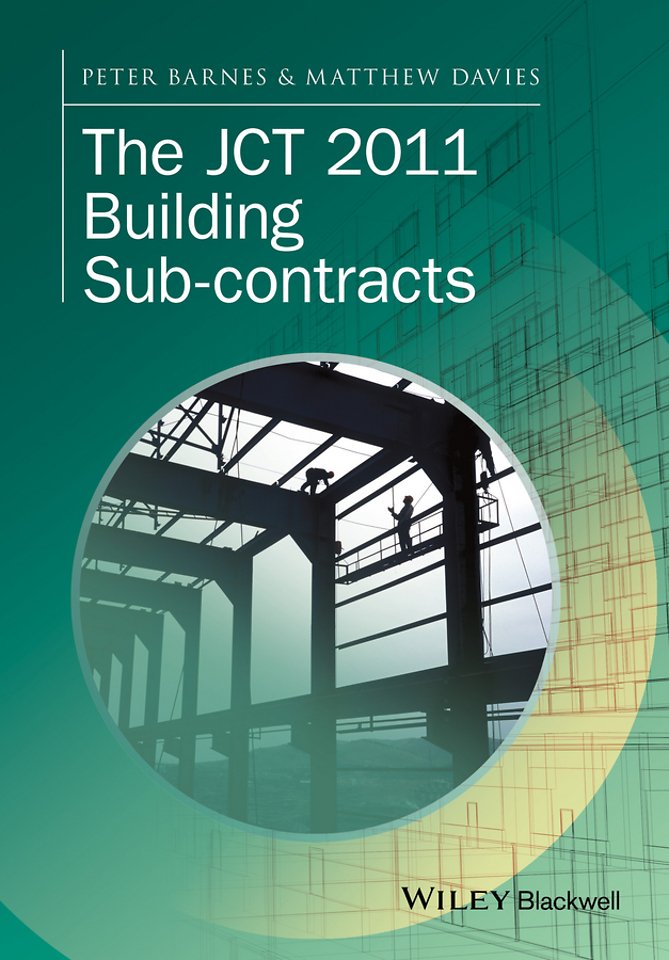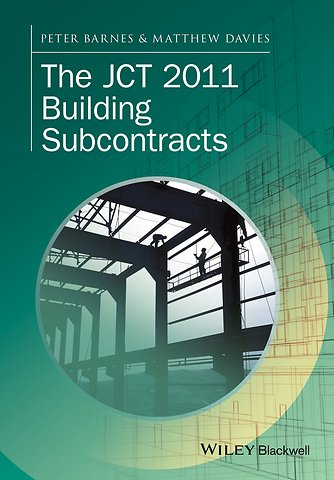The JCT 2011 Building Sub–contracts 2e
Samenvatting
The majority of construction work is carried out by subcontractors. As building projects become more complex, subcontractors need to understand the implications of the agreements they sign. The JCT 2011 Building Subcontracts has been written to help the busy subcontractor deal effectively with the range of JCT 2011 subcontracts they will encounter. It covers the most commonly use 2011 subcontracts, looking at the key contract conditions, the rights and obligations of the parties and how risk is allocated. A key element of the book is the discussion of the main practical problems that arise. Accessible and practical, this book will ensure building and construction subcontractors understand these contracts and have an easy to consult reference if any questions arise. It will also be of interest to main contractors, architects, contract administrators, project managers, quantity surveyors, contracts consultants and construction lawyers.
Specificaties
Inhoudsopgave
<p>1 Background and Introduction 1</p>
<p>1.1 The Joint Contracts Tribunal (JCT) 1</p>
<p>1.2 Sub–contracting 1</p>
<p>1.3 The formation of contracts and sub–contracts 2</p>
<p>1.4 Standard forms of contract and sub–contract 6</p>
<p>1.5 The JCT Sub–contracts dealt with within the chapters of this book 7</p>
<p>1.6 The JCT Sub–contracts not dealt with in the chapters of this book 10</p>
<p>2 The Sub–contract Agreement 17</p>
<p>2.1 Introduction 17</p>
<p>2.2 The structure of the sub–contract agreement 19</p>
<p>2.3 The recitals 20</p>
<p>2.4 The articles 22</p>
<p>2.5 The sub–contract particulars 23</p>
<p>2.6 Attestation forms 35</p>
<p>2.7 Schedule of information 37</p>
<p>2.8 Supplementary particulars 38</p>
<p>2.9 Equivalent sub–contract provisions 38</p>
<p>3 Definitions and Interpretations 44</p>
<p>3.1 Introduction 44</p>
<p>3.2 Definitions 44</p>
<p>3.3 Interpretation 45</p>
<p>3.4 Reckoning periods of days 46</p>
<p>3.5 Contracts (Rights of Third Parties) Act 1999 46</p>
<p>3.6 Giving of service of notices and other documents 46</p>
<p>3.7 Effect of the final payment notice (or the default payment notice) 47</p>
<p>3.8 Applicable law 49</p>
<p>3.9 Equivalent sub–contract provisions 49</p>
<p>4 Sub–contractors General Obligations 51</p>
<p>4.1 Introduction 51</p>
<p>4.2 General obligations 53</p>
<p>4.3 Sub–contractor s design 59</p>
<p>4.4 Materials, goods and workmanship 71</p>
<p>4.5 Compliance with main contract and indemnity 75</p>
<p>4.6 Errors, discrepancies and divergences 76</p>
<p>4.7 Equivalent sub–contract provisions 80</p>
<p>5 Time 85</p>
<p>5.1 Introduction 85</p>
<p>5.2 Time and the adjustment to the period for completion 86</p>
<p>5.3 Practical completion and lateness 96</p>
<p>5.4 Equivalent sub–contract provisions 98</p>
<p>6 Defects, Design Documents and Warranties 102</p>
<p>6.1 Introduction 102</p>
<p>6.2 Defects 103</p>
<p>6.3 Sub–contractor s design documents 107</p>
<p>6.4 Collateral warranties 108</p>
<p>6.5 Equivalent sub–contract provisions 113</p>
<p>7 Control of the Sub–contract Works 114</p>
<p>7.1 Introduction 114</p>
<p>7.2 Assignment and sub–letting 116</p>
<p>7.3 Person–in–charge 118</p>
<p>7.4 Access provided by the sub–contractor 119</p>
<p>7.5 Opening up the works and remedial measures 119</p>
<p>7.6 Attendance and site conduct 123</p>
<p>7.7 Health and safety and CDM 129</p>
<p>7.8 The CDM Regulations (i.e. the Construction (Design and Management) Regulations 2015) 135</p>
<p>7.9 Suspension of the main contract by the contractor 142</p>
<p>7.10 Benefits under the main contract 146</p>
<p>7.11 Certificates/statements or notices under the main contract 146</p>
<p>7.12 Equivalent sub–contract provisions 147</p>
<p>8 Payment 150</p>
<p>8.1 Introduction 150</p>
<p>8.2 The amount due in respect of interim payments 151</p>
<p>8.3 Unfixed materials 152</p>
<p>8.4 The amount due in respect of the final payment 153</p>
<p>8.5 Retention 156</p>
<p>8.6 Payment due dates and final dates for payment for interim payments 159</p>
<p>8.7 Payment Notices and Pay Less Notices for interim payments 160</p>
<p>8.8 The payment due date and the final date for payment for the final payment 162</p>
<p>8.9 Payment Notices and Pay Less Notices in respect of the final payment 162</p>
<p>8.10 VAT (Value Added Tax) 164</p>
<p>8.11 Construction Industry Scheme (CIS) 164</p>
<p>8.12 Interest 164</p>
<p>8.13 Sub–contractor s right of suspension 165</p>
<p>8.14 Fluctuations 166</p>
<p>8.15 Equivalent sub–contract provisions 167</p>
<p>9 Loss and Expense 171</p>
<p>9.1 Introduction 171</p>
<p>9.2 Can common law damages claims be excluded by the contract? 173</p>
<p>9.3 Are claims for extensions of time and loss and/or expense linked? 173</p>
<p>9.4 What are the grounds/requirements for loss and expense? 174</p>
<p>9.5 What are Relevant Sub–contract Matters? 174</p>
<p>9.6 Can the contractor recover direct loss and/or expense from the sub–contractor? 176</p>
<p>9.7 In pursuing a loss and expense claim, what does a sub–contractor need to prove? 177</p>
<p>9.8 What needs to be proved in a loss and expense claim document? 179</p>
<p>9.9 What is a global claim? 180</p>
<p>9.10 Common heads of a loss and expense claim 182</p>
<p>9.11 Prolongation costs 183</p>
<p>9.12 Disruption claims 186</p>
<p>9.13 Winter working 187</p>
<p>9.14 Head office overheads and profit 187</p>
<p>9.15 Loss of profit 190</p>
<p>9.16 Increased costs 190</p>
<p>9.17 Cost of claim preparation 191</p>
<p>9.18 Interest and finance charges 191</p>
<p>9.19 Acceleration 192</p>
<p>9.20 Common law damages 193</p>
<p>9.21 Equivalent sub–contract provisions 196</p>
<p>10 Variations 197</p>
<p>10.1 Introduction 197</p>
<p>10.2 What is a variation? 198</p>
<p>10.3 How is a variation instructed? 198</p>
<p>10.4 Can a variation vitiate a contract? 199</p>
<p>10.5 Must a sub–contractor comply with all variation directions issued? 200</p>
<p>10.6 Must a sub–contractor comply with all variation directions issued that may injuriously affect the efficacy of the sub–contractor s design? 200</p>
<p>10.7 What happens if a sub–contractor does not comply with a direction issued? 201</p>
<p>10.8 How should variations be valued? 201</p>
<p>10.9 How should variations that relate to a sub–contractor s design work be valued? 201</p>
<p>10.10 What is the procedure to be followed in respect of a schedule 2 quotation? 202</p>
<p>10.11 What are the valuation rules? 205</p>
<p>10.12 Equivalent sub–contract provisions 210</p>
<p>11 Injury, Damage and Insurance 214</p>
<p>11.1 Introduction 214</p>
<p>11.2 Sub–contractor s liability for personal injury or death 215</p>
<p>11.3 The sub–contractor s liability for injury or damage to property 216</p>
<p>11.4 The sub–contractor s liability for loss or damage to the sub–contract works 217</p>
<p>11.5 What Specified Perils insurance cover, in respect of loss or damage to works and site materials, does the sub–contractor obtain under the joint names all risks policies? 218</p>
<p>11.6 What is the sub–contractor s liability for damage to the sub–contract works? 218</p>
<p>11.7 What are the employer s options where terrorism cover is not available? 220</p>
<p>11.8 Is the contractor responsible for damage caused to the sub–contractor s plant, etc.? 221</p>
<p>11.9 Is the sub–contractor required to take out professional indemnity insurance? 221</p>
<p>11.10 When and how does the Joint Fire Code apply? 222</p>
<p>11.11 Equivalent sub–contract provisions 223</p>
<p>12 Termination of Sub–contract 226</p>
<p>12.1 Introduction 226</p>
<p>12.2 How can a contract come to an end? 227</p>
<p>12.3 What can cause a sub–contract to be terminated? 228</p>
<p>12.4 What is a breach of contract? 228</p>
<p>12.5 Will any breach of contract enable one to terminate the sub–contract? 228</p>
<p>12.6 What is a repudiatory breach at common law? 229</p>
<p>12.7 Why have termination provisions in the contract if the sub–contract can be terminated at common law? 229</p>
<p>12.8 What is the effect of a sub–contract being terminated at common law? 230</p>
<p>12.9 Are the effects of a sub–contract being terminated under common law or by contractual provisions the same? 230</p>
<p>12.10 Where can the contractual termination provisions be located in the Sub–contract? 231</p>
<p>12.11 Are the party s common law termination rights preserved under the Sub–contract? 231</p>
<p>12.12 What reasons give the contractor a right to terminate the sub–contractor s employment under the JCT Sub–contract Conditions? 231</p>
<p>12.13 What is deemed to be default by the sub–contractor under clause 7.4.1 of SBCSub/D/C? 231</p>
<p>12.14 What happens when a sub–contractor commits a specified default noted at clause 7.4.1 of SBCSub/D/C? 232</p>
<p>12.15 Must all notices either by the Contractor or the Sub–contractor referred to under Section 7 Termination of the sub–contract conditions be given in accordance with clause 1.7.4? 233</p>
<p>12.16 What does insolvency of the sub–contractor mean? 233</p>
<p>12.17 What happens when the sub–contractor becomes insolvent? 234</p>
<p>12.18 What does corruption entail? 235</p>
<p>12.19 What are the consequences of the contractor terminating the sub–contractor s employment? 235</p>
<p>12.20 What reasons give the sub–contractor the right to terminate his or her employment under the JCT subcontract conditions? 237</p>
<p>12.21 What is deemed to be default by the contractor under clause 7.8.1 of SBCSub/D/C? 237</p>
<p>12.22 What happens when a contractor commits a specified default noted under clause 7.8.1 of SBCSub/D/C? 238</p>
<p>12.23 What does insolvency of the contractor mean? 239</p>
<p>12.24 What happens when the contractor becomes insolvent? 239</p>
<p>12.25 What are the consequences of the sub–contractor terminating his or her own employment? 240</p>
<p>12.26 If a sub–contractor s employment is terminated for any reason, can it subsequently be reinstated? 242</p>
<p>12.27 Equivalent sub–contract provisions 242</p>
<p>13 Settlement of Disputes 245</p>
<p>13.1 Introduction 245</p>
<p>13.2 Mediation 245</p>
<p>13.3 Adjudication 247</p>
<p>13.4 Arbitration 253</p>
<p>13.5 Litigation 260</p>
<p>13.6 Equivalent Sub ]contract provisions 263</p>
<p>Table of Cases 265</p>
<p>Table of Statutes and Regulations 269</p>
<p>Index 271</p>
Net verschenen
Rubrieken
- aanbestedingsrecht
- aansprakelijkheids- en verzekeringsrecht
- accountancy
- algemeen juridisch
- arbeidsrecht
- bank- en effectenrecht
- bestuursrecht
- bouwrecht
- burgerlijk recht en procesrecht
- europees-internationaal recht
- fiscaal recht
- gezondheidsrecht
- insolventierecht
- intellectuele eigendom en ict-recht
- management
- mens en maatschappij
- milieu- en omgevingsrecht
- notarieel recht
- ondernemingsrecht
- pensioenrecht
- personen- en familierecht
- sociale zekerheidsrecht
- staatsrecht
- strafrecht en criminologie
- vastgoed- en huurrecht
- vreemdelingenrecht

